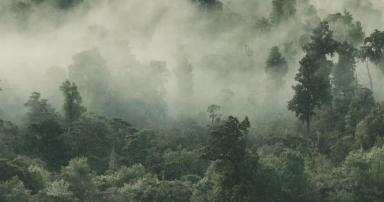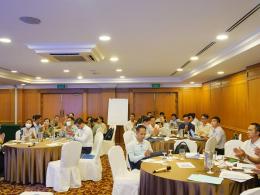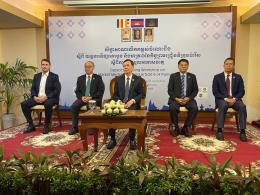
On 14th January 2013, a delegation of the Cambodia Climate Change Alliance programme, which consisted of CCCA staff and representatives from development partners including European Union, UNDP and the Embassy of Sweden visited CCCA beneficiaries at on-farm demonstration sites in Prey Veng Province.
According to recent research, this province is very vulnerable to the impacts of climate change, in particular to the negative effects of extended drought periods and more severe floods. Currently one of the CCCA’s grant projects is supporting farmers to respond to these climate change effects through appropriate adaptation measures and the project is titled “BUILD-FARM-ADAPT”.
The project is implemented as a demonstration project by the Royal University of Agriculture in collaboration with Chea Sim University of Kamchaymear in three districts of Prey Veng province namely Ba Phnom, Kamchaymear and Pea Reang. Two rice varieties, Chul’ Sa and Raing Chey, and enhanced agriculture technologies were introduced to farmers in order to improve crop yields, reduce pests and chemical fertilizer consumption.
CCCA delegates have been impressed by seeing those beneficiaries’ feeling very excited about these new varieties and technologies. “It is very interesting to see farmers feel that positive on these newly introduced varieties and techniques. Normally farmers are rightly reluctant to change their traditional crops overnight but these varieties have obviously taken the attention of the farmers” said Mr. Koen Everaert from the EU Delegation to Cambodia.
“I thank to CCCA for introducing Chul’Sa to my village and helping us with farming technologies. Now, we can get higher yield with less fertilizer and can harvest before flooding. I wish CCCA could spread this variety to the rest of my village.” said a CCCA’s beneficiary in a demonstration site in Phea Rieng District, Prey Veng Province.
Chul’ Sa and Raing Chey are among the Government top ten varieties. Both of them are recommended for the drought and flood prone areas. Chul’Sa is a short growing variety, which can be harvested less than 90 days; and farmers can plant it before and post flood. Raing Chey is a long growing variety, resistant to a long drought, therefore, it is good for drought prone areas. However, it can also tolerate up to 7 days of flooding.
To help farmer to adapt to climate change, the project encourages communities to grow other crops after rice harvesting. Peanuts are suggested to be grown in the dry season after rice as it can generate additional incomes and improve soil fertility.
The project also helps farmers to grow four types of grass for animals forage. The farmers are interested in growing more as they could see their animals grow much better after feeding with these forages.
Information about weather is crucial for farmers, so the project provides equipments and technical support to 3 sub-weather stations and 23 rang-gages in the three districts. The data collection will be analyzed by Provincial Department of Water Resources and Meteorology, then it is utilized by the project for farmer to arrange cropping schedule.



